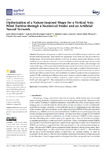Optimization of a nature-inspired shape for a vertical axis wind turbine through a numerical model and an artificial neural network

Use este enlace para citar
http://hdl.handle.net/2183/31773
A non ser que se indique outra cousa, a licenza do ítem descríbese como Attribution 4.0 International
Coleccións
- Investigación (EPEF) [592]
Metadatos
Mostrar o rexistro completo do ítemTítulo
Optimization of a nature-inspired shape for a vertical axis wind turbine through a numerical model and an artificial neural networkAutor(es)
Data
2022-08-11Cita bibliográfica
BlancoDamota,J.; RodríguezGarcía,J.d.D.;Couce Casanova,A.;Telmo Miranda,J.; Caccia,C.G.;LamasGaldo, M.I. OptimizationofaNature-Inspired ShapeforaVerticalAxis Wind TurbinethroughaNumerical Model andanArtificialNeuralNetwork. Appl.Sci.2022,12,8037. https:// doi.org/10.3390/app12168037
Resumo
[Abstract] The present work proposes an artificial neural network (ANN) to analyze vertical axis wind turbines of the Savonius type. These turbines are appropriate for low wind velocities due to their low starting torque. Nevertheless, their efficiency is too low. In order to improve the efficiency, several modifications are analyzed. First of all, an innovative blade profile biologically inspired is proposed. After that, the influence of several parameters such as the aspect ratio, overlap, and twist angle was analyzed through a CFD (computational fluid dynamics) model. In order to characterize the most appropriate combination of aspect ratio, overlap, and twist angle, an artificial neural network is proposed. A data set containing 125 data points was obtained through CFD. This data set was used to develop the artificial neural network. Once established, the artificial neural network was employed to analyze 793,881 combinations of different aspect ratios, overlaps, and twist angles. It was found that the maximum power coefficient, 0.3263, corresponds to aspect ratio 7.5, overlap/chord length ratio 0.1125, and twist angle 112. This corresponds to a 32.4% increment in comparison to the original case analyzed with aspect ratio 1, overlap 0, and twist angle 0.
Palabras chave
Wind turbines
VAWT
CFD
Savonius
Fibonacci
ANN
VAWT
CFD
Savonius
Fibonacci
ANN
Versión do editor
Dereitos
Attribution 4.0 International
ISSN
2076-3417






